#john bivens
Text
Bad Egg Publishing announces three new series!
Bad Egg Publishing announces three new series! #comics #comicbooks

View On WordPress
#alejandro arbona#altrverse#andrew dalhouse#bad egg publishing#brett weldele#charlie white#comic books#Comics#dave sharpe#david wellington#jacksepticeye#james asmus#john bivens#laura helsby#megan huang#plague seeker#skylar patridge#suzi blake#the somewhat incredible jackie boy man#vamkire trannel#void silver
41 notes
·
View notes
Text


Lamentation #2 by Cullen Bunn, Arjuna Susini and Hilary Jenkins. Cover by Yanick Paquette. Variant cover by John Bivens. Out in June.
"Trapped within the Requiem Theater, lead actress Jennifer fights for her life and freedom as threats encroach from the real world and within the play. When the mysterious Prince Razide selects her as his bride, new dangers emerge, and she still doesn't know who — or what — lies beneath the prince's mask. The Haunting of Hill House meets The Phantom of the Opera in this dizzying horror mystery by acclaimed writer of nightmares Cullen Bunn (Harrow County, The Empty Man, The Sixth Gun) and illustrator Arjuna Susini (Made Men, Forever Forward)."
#lamentation#oni press#cullen bunn#arjuna susini#hilary jenkins#yanick paquette#john bivens#variant cover#horror#comics
12 notes
·
View notes
Photo
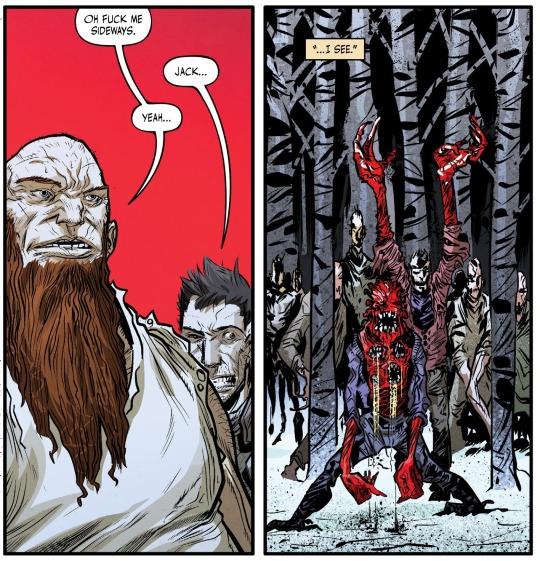
Spread #20
13 notes
·
View notes
Photo
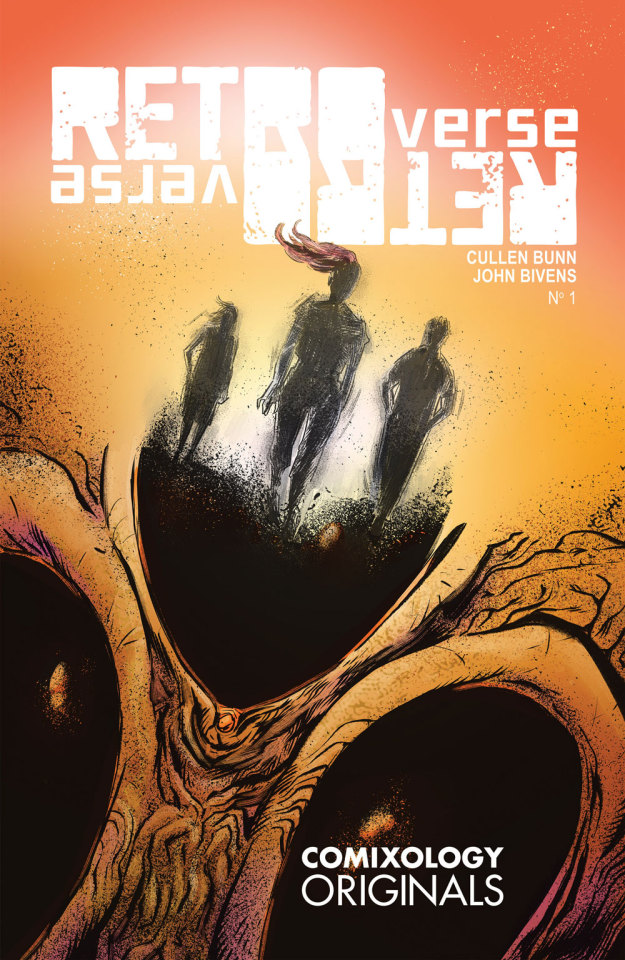


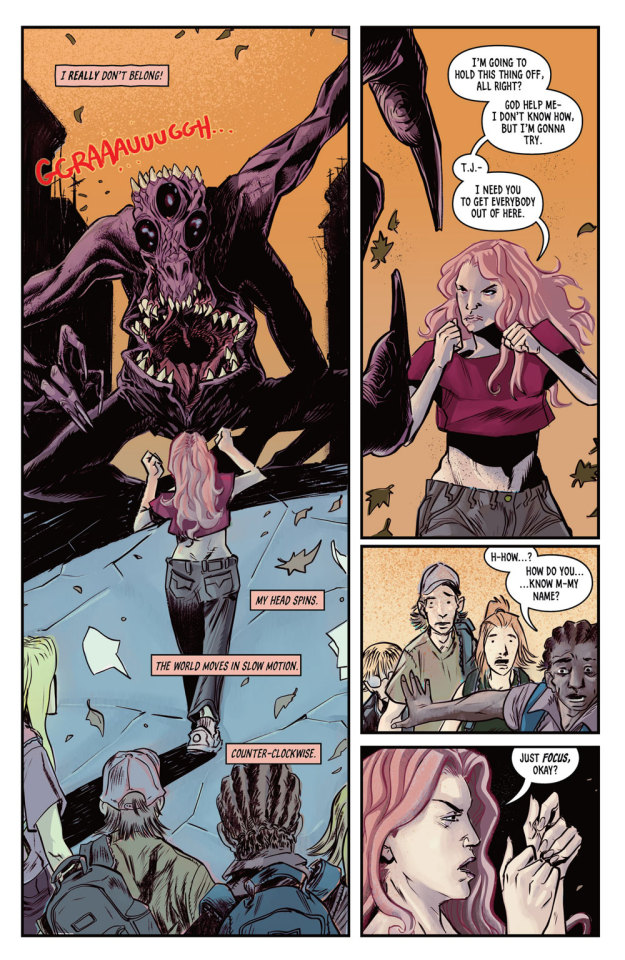



Preview pages from Retroverse #1 (Comixology Originals, December 2022) by Cullen Bunn and John Bivens
3 notes
·
View notes
Text
Lenni Reviews: "The Devil's Red Bride: The Complete Series" by Sebastian Girner, John Bivens, Iris Monahan & Jeff Powell
Lenni Reviews: “The Devil’s Red Bride: The Complete Series” by Sebastian Girner, John Bivens, Iris Monahan & Jeff Powell
(Image Source)
*This book was given to me in exchange for an honest review.
In 16th century Japan, Ketsuko takes on the mantle of “Red Devil” after her father dies and her entire clan is killed.
While this is action packed with some cool fantasy elements in the story, I feel like it needed more room to grow. I like the comic overall but I don’t get the chance to get to know everybody or what…

View On WordPress
#book review#Book Reviews#books#comic#comic review#comics#fantasy#fantasy comic#fantasy comics#graphic novel review#Iris Monahan#Jeff Powell#John Bivens#review#reviews#Sebastian Girner#The Devil&039;s Red Bride#The Devil&039;s Red Bride: The Complete Series
0 notes
Text
Forthcoming Comic Book Anthology— Soldier Stories—Shares Four Veteran Tales This November
Forthcoming Comic Book Anthology— Soldier Stories—Shares Four Veteran Tales This November
Top Cow gives veterans a voice through sequential storytelling in the upcoming, Soldier Stories. This anthology is set to release the week of Veterans Day, in honor of veterans, and will include the contributions of creators, Brian Anthony (USA), Jalysa Conway (UAF), Megan Ferrell Burke (USMC), and Rev. William J. Bellamy (ARNG).
“When Ken Pisani first approached us with this idea of putting out…
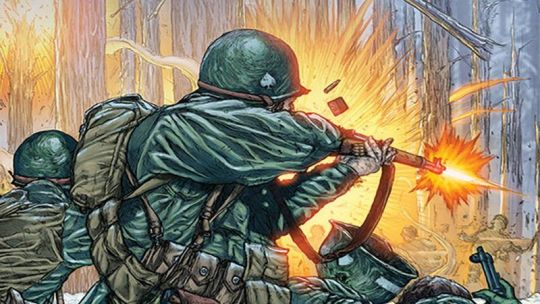
View On WordPress
#2022#Annapaola Martello#Arturo Lauria#Billy Tucci#Brian Anthony#Cecilia Lo Valvo#Image Comics#Jalysa Conway#John Bivens#K. Michael Russell#Kelly Fitzpatrick#Marc Silvestri#Megan Ferrell Burke#Rev. William J. Bellamy#Ryan Cody#Soldier Stories#Veterans Day
0 notes
Text
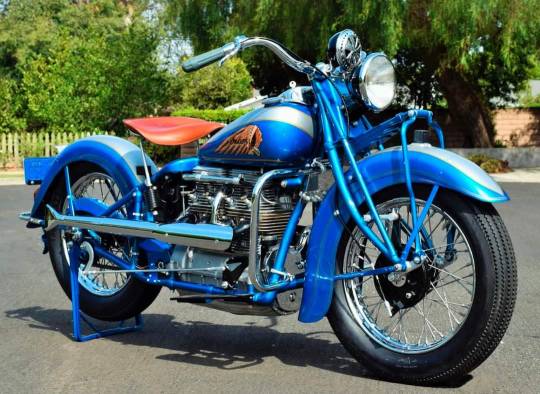
This absolutely spectacular 1939 Indian Model 439 is restored in World’s Fair colors, and it’s considered by many to be the best of all the Indian fours. While Indian had been building and improving its four-cylinder models since acquiring the Ace name, rights and tooling in 1927, it made considerable changes between 1936-38. Indian chose a radical redesign of the motor for 1936, which became known as the “upside-down fours” with exhaust-over-inlet cylinder heads. While these engines produced more power, they proved unpopular with riders as the exhaust ran close to the rider’s leg, which became uncomfortable in hot climates. After two years of production, the engine was totally redesigned all over again in 1938, this time with the usual inlet-over-exhaust configuration, albeit with many improvements, including for the first time a full enclosure of the valve gear, full lubrication of the valves and the cylinders cast in pairs. The resulting engine of the Model 438 was a far more attractive and more integrated design, with horizontal finning from the top of the valve enclosure right down to the radial finning on the crankcase sump.
Some consider the 1938-1942 Indian four engines to be among the most attractive motorcycle engines ever built. When combined with the spectacular styling of the late 1930s Indian range with sweeping, elegant fenders, teardrop tanks and perfect paint schemes, you have one of the most spectacular and beautiful motorcycles ever built in the 1938-39 Indians. Some consider the 1939 Indian 439 in a World’s Fair paint scheme—with its metallic silver or metallic blue—to be simply the finest expression of motorcycle art produced before World War II. These are the last of the rigid-frame Indian Fours, were 50 pounds lighter than the plunger-frame models that followed (the 439 weighed 480 pounds), and still came with sporting pretensions and an excellent new motor.
This 4-cylinder 1939 Indian Model 439 has had a spectacular restoration by Indian expert John Bivens. The engine was rebuilt by Dennis Young of “Ken Young and Sons Fours.” It’s a best of show winner with matching engine and frame numbers, and it’s about as pretty a motorcycle as you’re ever likely to see
#sportbike#biker bar#motorcycle#antique motorcycle#chopper#harley riders#vintage motorcycles#Harley Davidson#vintage harley#vintage harley davidson#classic harley davidson#biker events#Bikers#bike races#sport bike#biker bitches#Biker Girls#bike week#biker babes#biker chicks#Biker Rally#custom motorcycle#vintage motorcycle#motorcycle racing#Custom Chopper#classic motorcycle#Motorcycle Show#Biker Games#biker women#motorycle women
53 notes
·
View notes
Text
LÉGENDES DU JAZZ
UN BATTEUR SOUS-ESTIMÉ, JIMMY COBB
“When I was first starting out I used to hear Kenny Clarke play a certain way. He could play a little splash cymbal and it wouldn’t splash because he had such a good touch on the cymbal. So I just kind of fell into that. I didn’t just play four quarter notes; the little [swung] note was just soft. But I guess people only heard the quarter notes. Now it’s a little different; I dance with it a little bit on the cymbal, but it still has that same feeling.”
- Jimmy Cobb
Né le 20 janvier 1929 à Washington, D.C., Wilbur James Cobb était le fils de Wilbur Cobb, un gardien de sécurité et chauffeur de taxi, et de Katherine Bivens, une domestique. Au milieu des années 1940, Cobb avait développé une grande fascination pour le jazz en écoutant l’émission de radio du disc-jockey Symphony Sid.
À l’âge de treize ans, après avoir travaillé comme plongeur dans un comptoir-lunch, Cobb s’était ramassé suffisamment d’argent pour s’acheter sa première batterie. Cobb précisait: “When I first got my set of drums, I just set them up and played them, without looking at any music. I was trying to get some technique and find out if I liked the drums. When I could play a little bit, then I learned to read.’’
DÉBUTS DE CARRIÈRE
Même s’il avait étudié brièvement avec le percussionniste de la National Symphony Jack Dennett, Cobb a essentiellement appris à jouer de la batterie en autodidacte.
Après avoir joué de la batterie avec le groupe de son high school, Cobb n’avait pas tardé à obtenir ses premiers contrats de musicien professionnel. Décrivant ses débuts, Cobb avait expliqué: "I figured it was something I'd like to do, and when I learned enough to do it, I figured that would be what I would do for the rest of my life." Au cours d’une autre entrevue, Cobb avait précisé: “It was during World War II, and it was easy for someone just getting started to get a job because many guys had been drafted and gone to war.”
Même s’il avait également été influencé par Kenny Clarke, Cobb considérait Max Roach comme sa principale influence. Il expliquait: “At the time, that was the hippest music going. I also listened to Kenny Clarke, Shadow Wilson, and Big Sid Catlett. Then a little later there was Art Blakey and Philly Joe Jones.”
Cobb n’avait pas encore vingt ans lorsqu’il avait commencé à jouer avec les plus grands musiciens de jazz de l’époque. Après avoir accompagné la chanteuse Billie Holiday lors d’un de ses passages à Washington, Cobb s’était joint au groupe itinérant du disc-jockey Symphony Sid, ce qui lui avait permis de passer une semaine aux côtés de Charlie Parker et Miles Davis.
Cobb avait obtenu son premier contrat majeur dans le cadre d’une collaboration avec le saxophoniste Charlie Rouse. Cobb expliquait:
‘’He was from Washington and had been to New York. Rouse had worked with Dizzy Gillespie and all the bebop musicians, so he knew all the tunes. I had a job with him at the Republic Gardens on U Street in Washington. I was about 18. That’s how I started playing jazz. I wanted to play jazz because I always heard it in the neighborhood. My friends would play Billy Eckstine records—the hard swing, bebop thing. Eckstine’s band had stars like Dexter Gordon, Charlie Parker, and Gene Ammons. That’s the kind of music I’ve been listening to all my life.”
Durant son séjour à Washington, Cobb avait également joué avec Leo Parker, Benny Golson, Billie Holiday et Pearl Bailey. En 1950, à l’âge de vingt et un ans, Cobb s’était installé à New York où il avait fait ses débuts sur disque avec le groupe du saxophoniste Earl Bostic, qui comprenait à l’époque de futurs sommités du jazz comme John Coltrane, Benny Golson et Stanley Turrentine. Décrivant cette période de sa vie, Cobb avait commenté:
“During those times the band used to travel to different places. In each city there was a variety theater and the band would have to play the show. We had a sextet and they would add other musicians to make a 13-piece band. I only stayed with Bostic a year. After that I went with Dinah Washington, and the same thing prevailed. You’d have an augmented band and play for other acts. It was good experience. Also, when I was with Diana we did a good record called For Those in Love that had some of Quincy Jones’s first arrangements.”
Par la suite, Cobb avait travaillé durant trois ans et demi avec la chanteuse Dinah Washington, amorçant ainsi une collaboration de vingt ans avec le pianiste Wynton Kelly. Cobb a également participé à plusieurs des enregistrements de la chanteuse, dont le très sous-estimé ‘’For Those In Love’’, pour lequel Quincy Jones avait écrit les arrangements. C’est lors de sa collaboration avec Washington que Cobb avait commencé à saisir le fossé qui existait entre son éducation catholique et les traditions de l’église baptiste. Il précisait: “When I heard that Baptist sound, it took me over. I wasn’t used to hearing that. It would make the hairs stand up on my arms and neck, where people are singing and shouting in church. That struck me right away. She taught me to put the passion into what I was doing.”
Après avoir quitté le groupe de Washington en 1956, Cobb s’était joint au quintet des frères Cannonball et Nat Adderley dont il avait fait partie durant environ un an. Cobb expliquait:
“I met Julian [Cannonball] when I was with Dinah Washington. He was still in Florida, and when we played there, he came to the hotel we were staying in because he wanted to talk to somebody from New York and find out what the scene was because he was thinking about coming up. After Charlie Parker died, I guess he figured he had a shot. So later on when he and Nat came to New York he hired me for their band, and we made an album called Sharpshooters, which was a pretty good album.”
Cobb avait enregistré trois albums avec les frères Adderley: ‘’Sophisticated Swing’’, ‘’Quintet In Chicago’’ et ‘’Takes Charge.’’
Parallèlement à sa collaboration avec les frères Adderley, Cobb avait travaillé avec Stan Getz et Dizzy Gillespie. Il avait également enregistré avec le percussionniste Tito Puente. En 1957, Cannonball Adderley s’était joint au groupe de Miles Davis. Un jour, le batteur Philly Joe Jones n’avait pu se présenter, et Cannonball avait invité Cobb à se joindre à la formation. Cobb précisait:
“So Julian told me to come by when they were playing, and if Joe didn’t show up I could play. So I did that a lot,and then I went to a record date with them one day and Joe didn’t show up, so they pressed me into service, and that record date was for Porgy and Bess. They had already done about half of it with Joe, and I’m on the other half. Sometimes we’re each doing half of the same tune. So I finished the date, and a little while after that Miles asked me to be in the band.’’
Cobb avait déjà travaillé avec Davis auparavant. Cobb expliquait: “When I was with Diana {Dinah Washington}, a disc jockey called Symphony Sid gathered a lot of musicians together and called them Symphony Sid’s All-Stars, and he had Charlie Parker, Miles Davis, Milt Jackson, and Toots Thielemans, who had just come from Belgium, and Diana’s rhythm section. We played together for a week.”
L’album ‘’Kind of Blue’’ avait été enregistré au printemps 1959 peu après le 30e anniversaire de naissance de Cobb. Faisaient également partie du groupe les saxophonistes John Coltrane et Cannonball Adderley, les pianistes Wynton Kelly et Bill Evans, et le contrebassiste Paul Chambers. Davis, qui faisait énormément confiance à Cobb, lui avait donné une seule instruction: "Jimmy, you know what to do. Just make it sound like it's floating." Enregistré dans une ancienne église de la 30e rue de New York qui avait été transformée en studio pour l’occasion, l’album avait été pratiquement réalisé en une seule prise. Comme Cobb l’avait expliqué lors de la célébration du 50e anniversaire de l’album en 1959, «Miles pensait que le premier coup était toujours le meilleur, sinon c’était du rabâchage». Cobb avait ajouté: «Miles est juste arrivé avec quelques idées sur un bout de papier. On a dû travailler pour construire à partir de ce peu de choses, mais ça a été facile.»
À l’époque, personne ne se doutait que ‘’Kind of Blue’’ deviendrait un des meilleurs disques de jazz de tous les temps. Cobb précisait: “It was just another Miles Davis record date. When we went in, I didn’t have any music. He probably had some lead sheets for the guys. It was an ordinary date, but we were playing some different music that sounded like Bill Evans, Gil Evans, and Miles Davis. It was the modal thing, and that was the first time we had done that.”
Rémunéré au tarif de base (c’est-à-dire environ 100$ pour l’ensemble des sessions de l’album), Cobb n’avait jamais reçu aucun droit d’auteur pour sa participation à l’album qui s’était écoulé à plus de quatre millions d’exemplaires, devenant ainsi l’album de jazz le plus vendu de tous les temps. Transcendant les limites du jazz, l’album avait été classé au 12e rang des 500 plus grands albums des tous les temps par le magazine Rolling Stone.
Cobb a également participé à plusieurs autres albums de Davis, dont ‘’Sketches of Spain’’ (1960), ’’Someday My Prince Will Come’’ (1961), ’’Live at the Blackhawk’’, ’’Miles Davis at Carnegie Hall’’ (1961), ’’In Person Friday and Saturday Nights at the Blackhawk'' (1961) et ''Complete’’. Cobb a aussi fait de brèves apparitions sur les albums ‘’Porgy and Bess’’ (1959) et ‘’Sorcerer ’’ (1967).
Parallèlement à sa collaboration avec le groupe de Davis, Cobb a aussi enregistré avec plusieurs autres grands noms du jazz, dont Cannonball Adderley, John Coltrane, Paul Chambers, et Wynton Kelly (tous des membres du groupe de Davis), ainsi qu’avec Kenny Dorham, Wayne Shorter, Paul Gonsalves, Art Pepper, Bobby Timmons, Donald Byrd et Pepper Adams. Cobb a également fait une apparition sur un album de 1960 intitulé ‘’Son of Drum Suite.’’ L’album faisait suite à un premier album intitulé ‘’The Drum Suite.’’ La pièce ‘’’Son of Drum Suite’’ était une composition en six mouvements écrite et arrangée par le saxophoniste Al Cohn. Outre Cobb, l’album avait été enregistré avec une formation composée de Mel Lewis, Don Lamond, Charli Persip, Louis Hayes, Gus Johnson, Clark Terry, Bob Brookmeyer et Zoot Sims. À peu près à la même époque, Cobb avait participé à Gretsch Drum Nights, des performances mettant en vedette les batteurs Elvin Jones, Alan Dawson et Art Blakey.
Lorsque Cobb avait quitté le groupe de Davis en 1962, Tony Williams avait assuré sa relève. Cobb expliquait: “I was playing on some records for Riverside at the time, and the day after I left Miles Davis’s band, I recorded Boss Guitar with Wes Montgomery.’’ Peu après, Cobb avait formé un trio avec deux ex-membres du groupe de Davis, Paul Chambers et Wynton Kelly. En plus de jouer et d’enregistrer avec le Wynton Kelly Trio, les trois musiciens étaient partis en tournée avec Montgomery tout en l’accompagnant sur quelques-uns de ses albums, dont ‘’Smokin’ at the Half Note’’ et ‘’Willow Weep for Me.’’ Le trio, qui avait également collaboré avec J.J. Johnson, John Coltrane, Wayne Shorter, Benny Golson, Hank Mobley, Art Pepper, Kenny Burrell et Joe Henderson, avait poursuivi ses activités jusqu’à la mort de Chambers en 1969.
De 1970 à 1978, Cobb avait également accompagné la chanteuse Sarah Vaughan. Décrivant sa collaboration avec la chanteuse, Cobb avait commenté: “Since joining Sarah, I’ve been around the world. One year we went to four continents. It’s an education just to be on this job, because we do a lot of things—trio, big-band, and symphony jobs. It’s educational.” Cobb considérait d’ailleurs l’album ‘’Sarah Vaughan: Live in Japan’’ comme un de ses favoris.
Parmi les musiciens que Cobb avait accompagnés dans les années 1970, 1980 et 1990, on remarquait notamment Sonny Stitt, Nat Adderley, Ricky Ford, Hank Jones, Ron Carter, George Coleman, David “Fathead” Newman, David Liebman, Art Farmer, Kenny Drew, John Hicks, the Great Jazz Trio, Nancy Wilson, Dave Holland et Warren Bernhardt.
DERNIÈRES ANNÉES
Très appécié comme accompagnateur, Cobb n’avait pas enregistré sous son nom avant le début des années 1980. Publié en 1983, le premier album de Cobb comme leader éait intitulé ‘’So Nobody Else Can Hear.’’ L’un des principaux groupes de Cobb était une formation appelée Jimmy Cobb’s Mob. Le groupe avait publié plusieurs albums, dont ‘’Four Generations of Miles’’ (un hommage à Miles Davis enregisré avec le guitariste Mike Stern, le contrebassiste Ron Carter et le saxophoniste George Coleman), ‘’Yesterdays’’ (enregistré avec Michael Brecker au saxophone ténor, Marion Meadows au saxophone soprano, Roy Hargrove à la trompette et au flugelhorn, et Jon Faddis à la trompette), ‘’New York Time’’ (avec Christian McBride à la contrebasse, Javon Jackson au saxophone ténor et Cedar Walton au piano), ‘’West of 5th’’ (avec Hank Jones au piano et Christian McBride à la contrebasse), et ‘’Cobb’s Corner’’ (avec Roy Hargrove à la trompette, Ronnie Matthews au piano et Peter Washington à la conttrebasse).
Dans les années 1980, Cobb a également travaillé régulièrement avec le trompettiste Nat Adderley. En 1986, Cobb avait enregistré son premier CD (et son premier vidéo) pour le réseau A & E.
Dans les années 1990, Cobb avait continué d’enregistrer et de participer à de nombreuses tournées aux États-Unis et en Europe.
Au début des années 1990, Cobb avait également été en vedette dans un spécial télévisé intitulé "So that Nobody Else Can Hear", dans lequel on le voyait jouer aux côtés de grands noms du jazz comme Freddie Hubbard, Gregory Hines, Bill Cosby, Dave Leibman et Pee Wee Ellis. L’émission était produite par son épouse Eleana Tee Steinberg Cobb.
Dans les années 1990, Cobb avait commencé à prendre sous son aile plusieurs jeunes musiciens comme les trompettistes Roy Hargrove et Wallace Roney, le guitariste et compositeur Peter Bernstein, le saxophonise ténor Eric Alexander, le contrebassiste Christian McBride, et surtout le pianiste Brad Mehldau, qui avait fait partie de la première édition de son groupe Cobb's Mob à la New School of Music. Saluant les qualités d’enseignant de Cobb, un autre de ses anciens étudiants, le guitariste Peter Bernstein, écrivait dans les notes de pochette de l’album ‘’This I Dig Of You’’: "As a drummer, he makes you feel so comfortable. Like, this is what it's supposed to feel like."
Cobb avait continué de jouer et d’enseigner autour du monde jusqu’à sa mort. La famille de Cobb - Eleana Steinberg Cobb et ses deux filles Serena et Jaime, avaient planifié l’agenda de Cobb à la fin de sa vie. Cobb avait été marié auparavant à Ann Porter, mais celle-ci était décédée en 1987.
Jimmy est mort le 24 mai 2020 à sa résidence de Manhattan York d’un cancer des poumons. Il était âgé de quatre-vingt-onze ans. De nombreux musiciens de jazz avaient souligné le décès de Cobb sur les médias sociaux, dont Todd Barkan, qui avait déclaré: ‘’his is a devastating loss—the death of a beloved musician, but also the end of an era, as we lose the last surviving member of a historic ensemble.’’ Quant à Ralph Peterson, il avait commenté: ‘’Grandmaster Jimmy Cobb has joined the ancestors… Thank you for leaving so much to so many… Rest In Peace Jazz Warrior.’’ Trois mois avant sa mort, une des filles de Cobb, Serena, avait lancé une campagne de financement afin d’aider son père à défrayer les coûts de son hospitalisation qui étaient devenus trop élevés pour ses faibles revenus. Serena avait déclaré dans le communiqué qui accompagnait dans le communiqué qui accompagnait le lancement de la campagne de souscription: “He’s dedicated the last 70 years of his life to the art of jazz, and although there’s nothing he’d rather do than continue to support himself and his family while doing what he loves, it has become far too difficult of a task.”
Considéré comme un des batteurs qui avaient contribué à définir le style post-bop dans les années 1950 et 1960, Cobb a influencé de nombreux batteurs, dont Jack DeJohnette, qui avait déclaré à son sujet:
“The first time I heard Jimmy was on Kind of Blue, and what got my attention was his touch and keen sense of dynamics. You can always count on Jimmy to provide the rightsupport for whatever the music or musicians call for. That’s why Jimmy was always called upon by the greats in jazz and will always be respected by the community. Also, he is a really good human being, and I am happy to know him.”
Malgré le succès de l’album ‘’Kind of Blue’’, Cobb n’était pas aussi bien connu du grand public que certains autres batteurs, sans doute parce qu’il était beaucoup moins charismatique et extraverti que ses contemporains Philly Joe Jones, Elvin Jones et Roy Haynes. Cobb était par contre très estimé des autres musiciens qui appréciaient son jeu subtil et discret et sa façon de tenir le rythme qui pouvaient ainsi s’intégrer plus facilement dans le son de leurs propres formations. Particulièrement influencé par Kenny Clarke, Cobb avait expliqué:
“When I was first starting out I used to hear Kenny Clarke play a certain way. He could play a little splash cymbal and it wouldn’t splash because he had such a good touch on the cymbal. So I just kind of fell into that. I didn’t just play four quarter notes; the little [swung] note was just soft. But I guess people only heard the quarter notes. Now it’s a little different; I dance with it a little bit on the cymbal, but it still has that same feeling.”
Reconnu internationalement, Cobb s’est produit un peu partout à travers le monde, de Newport à Monte Carlo, en passant par Los Angeles et le Japon. Cobb a également joué devant le président Jimmy Carter, le Shah d’Iran et plusieurs autres personnalités politiques.
La liste des musiciens avec lesquels Cobb a collaborés au cours de sa carrière était un véritable Who’s Who de l’histoire du jazz: Dinah Washington, Pearl Bailey, Clark Terry, les frères Cannonball et Nat Adderley, Dizzy Gillespie, John Coltrane, Sarah Vaughan, Billie Holiday, Wynton Kelly, Stan Getz, Wes Montgomery, Gil Evans, Miles Davis, Paul Chambers, Kenny Burrell, J. J. Johnson, Sonny Stitt, David Liebman, Hank Jones, Ron Carter, George Coleman, David ‘’Fathead’’ Newman, Geri Allen, Earl Bostic, Leo Parker, Charlie Rouse, Ernie Royal, Philly Joe Jones, John Hicks, Bobby Timmons, Benny Golson, Walter Booker, Jerome Richardson, Art Farmer, Kenny Drew, Keter Betts, Jimmy Cleveland, Sam Jones, Art Pepper, Pepper Adams, Paul Gonsalves, Red Garland, Joe Henderson, Eddie Gomez, Bill Evans, Stefan Karlsson, Donald Byrd, Jeremy Steig, Wayne Shorter, Hank Mobley, Richard Wyands, Dave Holland, Kenny Dorham, Peter Bernstein, Richie Cole, Nancy Wilson, Ricky Ford, Sarah Vaughan et David Amram, pour n’en mentionner que quelques-uns.
Cobb, qui était aussi professeur, a donné des classes de maître à la Stanford University Jazz Workshop. Cobb a égalemen enseigné dans plusieurs autres institutions scolaires, dont The New School for Jazz and Contemporary Music de New York, la New School for Social Research, le Brooklyn-Queens Conservatory of Music, la Florida State University, l’Université de Greensboro en Caroline du Nord, et l’International Center for the Arts de la San Francisco State University. Cobb a également enseigné dans des écoles d’été organisées en Europe par l’Université Duke, en Caroline du Nord.
Décrivant son travail de professeur, Cobb avait déclaré: “Most of the drummers I get can already play. The first thing I ask them is, what do they want that they think they can get from me? Most of them want to learn that cymbal beat." Jusqu’à la fin, les étudiants de Cobb n’avaient jamais cessé de lui demander comment il pouvait jouer avec une telle facilité. Cobb répondait le plus souvent qu’il n’y avait aucun secret, avant d’ajouter: "The first thing is they have to love it, and stay with it." Loin de s’enfler la tête avec ses nombreuses réalisations, Cobb avait commenté: "I've been in the right place at the right time a lot of times. [But today] things are more mechanical than human, than they used to be. [Students today] got some advantages, because they have videos and all that, but it's not walking up and shaking the dude's hand and talking about things, or asking him questions."
Jimmy Cobb a remporté de nombreux honneurs au cours de sa carrière. En juin 2008, la Michigan State University avait décerné à Cobb le Don Redman Jazz Heritage Award. Le 17 octobre suivant, Cobb avait fait partie des six musiciens qui avaient obtenu le titre de ‘’Jazz Master’’ attribué par la National Endowment for the Arts (NEA). Cobb avait accepté son prix en lisant la déclaration suivante:
"I am humbled to be included among the great musicians in our American history. I express my gratitude to these jazz giants, many of whom were close friends, who shaped this great American art form called jazz and ultimately helped to shape my life as well. I thank the NEA committee for recognizing America's jazz masters and the art of jazz itself and I am honored and privileged to be a part of this legacy."
Interrogé dans le cadre d’un programme d’histoire orale parrainé par le musée Smithsonian après la remise de son prix, Cobb avait attribué une grande partie de sa sensibilité comme batteur au fait d’avoir accompagné des chanteuses comme Dinah Washington et Sarah Vaughan. Il expliquait: "I guess the sensitivity probably comes from having to work with singers, because you have to really be sensitive there. You have to listen and just be a part of what's going on." En 2006, à l’occasion de son 75e anniversaire de naissance, Cobb a également été honoré par Wynton Marsalis dans le cadre de la Marsalis Music Honor Series.
En décembre 2009, la Chambre des Représentants avait honoré Cobb à l’occasion du 50e anniversaire de l’album ‘’Kind of Blue’’. La même année, Cobb, qui était le dernier membre survivant du groupe de Davis, avait dirigé le groupe ‘’So What’’ qui visait à commémorer le 50e anniversaire de la publication de l’album ‘’Kind of Blue.’’ Le groupe, qui comprenait le trompettiste Wallace Roney et les saxophonistes Javon Jackson et Vincent Herring, avait par la suite fait une tournée au Royaume-Uni. En 2000, Cobb a également écrit la préface de l’ouvrage ‘’Kind of Blue: the Making of the Miles Davis Masterpiece’’ d’Ashley Kahn. Cobb avait aussi enregistré un album en hommage à Davis intitulé ‘’Remembering Miles.’’ Au cours de la même période, Cobb était également parti en tournée avec son groupe afin de rendre hommage à John Coltrane.
Partisan de l’élection de Cobb au sein du Percussion Arts Society Hall of Fame, le batteur Peter Erskine avait déclaré: “It’s fitting and appropriate that this assembly of percussionists give Jimmy Cobb the greatest honor possible. Simply put, the world’s a better place because of Jimmy Cobb’s drumming, and it’s delightful to know he is being inducted into the PAS Hall of Fame. The PAS is a better place now for this.”
©-2024, tous droits réservés, Les Productions de l’Imaginaire historique
0 notes
Photo

Armed with strange alien weapons, Kacy faces the hideous Patchwork Man in a final conflict
EXCLUSIVE PREVIEW: The Exciting Conclusion of 'Retroverse' #5 by Cullen Bunn and John Bivens
https://www.lotuslandcomics.com/2023/04/exclusive-preview-exciting-conclusion.html
0 notes
Text
Veterans will tell their stories in Top Cow's Soldier Stories
Veterans will tell their stories in Top Cow's Soldier Stories #comics #comicbooks
Top Cow gives alternative veteran voices a platform to tell their stories in Soldier Stories. The anthology is set to release the week of Veterans Day on November 9th to honor veterans, including the creators of this anthology: Brian Anthony (USA), Jalysa Conway (UAF), Megan Ferrell Burke (USMC), and Rev. William J. Bellamy (ARNG). Ken Pisani (AMP’D), is a Los Angeles Times best-selling author…

View On WordPress
#annapaola martello#arturo lauria#billy tucci#brian anthony#cecilia lo valvo#comic books#Comics#image comics#jalysa conway#john bivens#k. michael russell#kelly fitzpatrick#marc silvestri#megan ferrell burke#ryan cody#soldier stories#top cow productions#william j. bellamy
2 notes
·
View notes
Text
Cult Classic Creature Feature #4

Cult Classic Creature Feature #4
Vault Comics 2019
Created & Written by Eliot Rahal
Illustrated by John Bivens
Coloured by Jerrie & Monahan
Lettered by Taylor Esposito of Ghost Glyph Studio
The Genie has been let out of the bottle. But in this case... the Genie is actually an army of undead skeleton monsters. Can Jarrod and his crew survive the end of the world? After tonight, will they want to?
I am really, really loving this series. Eliot manages to capture everything about the Late Night Double Feature Picture Show in the vein of Svengoolie and the others. It has this perfect blend of seriousness alongside that kitsch factor that puts over the top and honestly it is very much like the films from the 50's that Russell Johnson used to be featured in. There is just so much here to enjoy for a myriad of reasons the least of which is that this is very well written and illustrated.
Eliot is one of those who have paid his dues over the years and to see him getting the chance to shine here like this is sensational. Now if he's just bring the Doorman to Vault I would be over the moon with excitement and happiness. Sometimes you follow creators because you truly like and enjoy their work and while Eliot is humble about it, he's really grown and blossomed as a writer and it's been great to watch happen. The story & plot development we see through how the sequence of events unfold and how the reader learns information is laid down extremely well. The character development is fantastic and the kids are so endearing, likeable and relatable to. The pacing is superb and as it takes us through the pages and reveals the twists and turns along the way helps create the books great eb & flow.
Vault has this habit of finding these projects to back that have just the right amount of intrigue to them that inevitably because a nice little hit. This is no different. It fits right in what the whole science fiction theme the company has and with equal amounts of humour and horror this easily becomes one of those go-to franchises. I am impressed with the personalities of the characters that we see as well, it's nice to see more diversity in these folks instead of something generic. So we do have those we like, those we don't and those who we wish would have their skeletons come out their mouths.
The work we see on the interiors here with the creativity and imagination on full display is just as good as the writing is. Granted I would like to see backgrounds utilised more but it is what it is. How we see the linework and it's varying weights utilised is phenomenal! These skeleton's and how we see them is not only anatomically correct but damn if they aren't spooky as all get out I mean this is the kind of stuff that we wanted to see on Scooby-Doo! Add the colour work into the skeleton's and they really have such a strong and powerful impact. The utilisation of the page layouts and how we see the angles and perspective in the panels show a talented eye for storytelling. The colour work throughout is really well rendered. The way we see the colours and the hues and tones within them to create the shading, highlights and shadow work is beautifully done. I love how it also creates the mood, tone and feel for every moment.
While we don't have a host per se it wouldn't be terrible if Berwyn were to be that guy. He is pretty much a despicable person but since this is happening it is doubtful that he'll have to close the station and if things go well he can milk this event into a cash cow. This would be a perfect segue into the next arc. I like that Eliot manages to engage the reader so they think beyond what's on the page which of course gets the reader invested into the series as well. This is a darn good time and ya know what I wouldn't mind seeing these folks tackle some Dragula, the Boulet Brothers to be exac, hell those two would be incredible hosts for a series hmmm.

2 notes
·
View notes
Photo

Comixology Originals announces ‘Retroverse’ by Bunn + Bivens
The new series will arrive on the platform next week.
0 notes
Photo
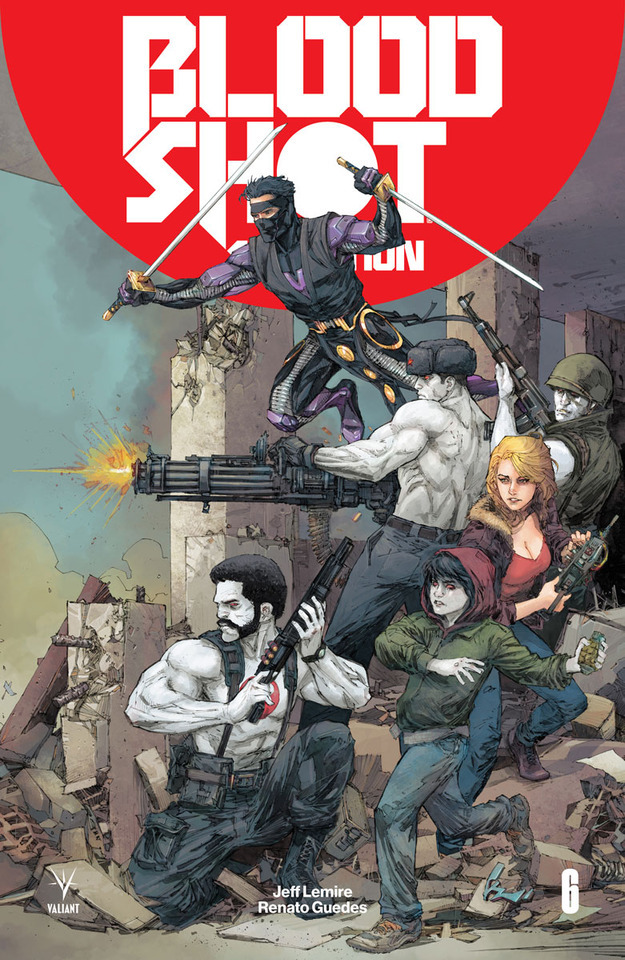



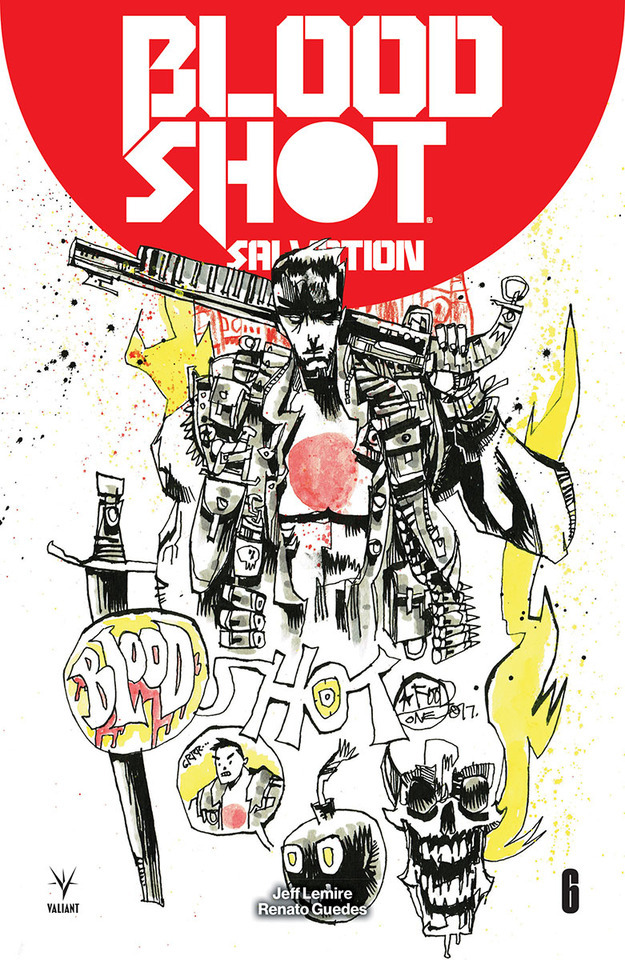
BLOODSHOT SALVATION #6 (NEW ARC! “THE BOOK OF THE DEAD)
Written by JEFF LEMORE
Art by RENATO GUEDES
Cover A (Standard) by KENNETH ROCAFORT
Cover B (Deadside) by RENATO GUEDES
Cover C (Battle Damaged) by JOHN BIVENS
Interlocking Variant by DAVID LAFUENTE
Bloodshot Icon Variant By JIM MAHFOOD
ALL-NEW ARC! ALL-NEW JUMPING-ON POINT! “THE BOOK OF THE DEAD” – PART ONE!
Into the Deadside! Years ago, Project Rising Spirit’s cutting-edge nanite technology transformed Ray Garrison into the walking weapon codenamed Bloodshot. Now, those very same microscopic machines have infected his infant daughter’s physiology and threaten to destroy her from the inside out. As the life of an innocent hangs in the balance, Bloodshot will be forced to make an unimaginable decision: to watch the child he loves die, or to confront death itself…and strike a bargain for her safety. Now, with the supernatural heroes known as Shadowman and Dr. Mirage to guide him, Bloodshot is about to undertake an unreal journey into the demon-haunted dimension known as the Deadside to save a life…or sacrifice his own…
Plus: Magic and the Bloodshot Squad lead an assault on Omen for the rescue attempt of a lifetime! A wrenching new chapter for Valiant’s powerful series starts here as New York Times best-selling writer Jeff Lemire (Black Hammer) leads Bloodshot to the precipice of loss, grief, and retribution – featuring fully painted interior art by sensational rising star Renato Guedes (X-O MANOWAR)!
$3.99 | 32 pgs. | VALIANT PREMIUM | T+ | On Sale FEBRUARY 14th
43 notes
·
View notes

